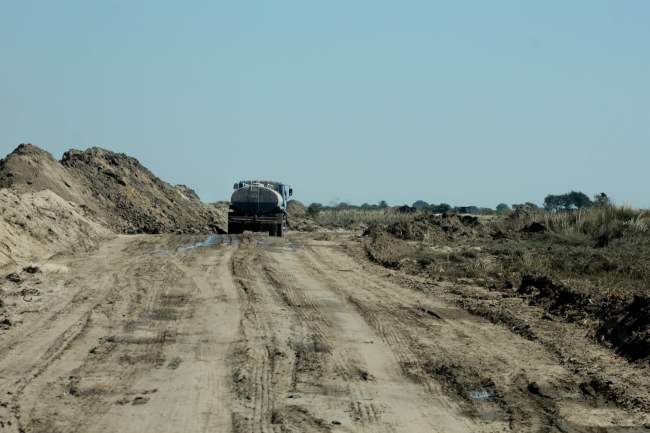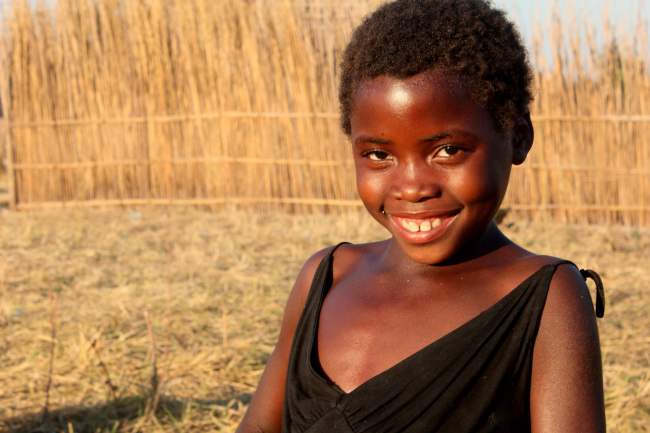So, after substantially correcting the disorganized questionnaire from the first round, our second round of data collection for the fish value chain research has started. We are hopeful that this time the data will be more accurate and meaningful. But we needed to be vigilant about how authentically and correctly the data is being collected. It is not that we are undermining the capacity and sincerity of our enumerators. But it is also true that when supervision is sloppy, the resulting work is almost always poor. From my limited experience, I have gathered strong doubts about the effectiveness of data management in the development sector. May be this is one of the reasons why we have many more unsuccessful or “pseudo-successful” projects than the really successful ones.
- The roads under construction from Mongu to Kalabo
Hence we hit the road. We are using the makeshift “so-called” road from Mongu to another district headquarter Kalabo. Kalabo is situated on the other side of Zambezi, beyond the floodplain. Making a road across the floodplain is extremely challenging. Previous two attempts actually failed. Currently the Chinese are executing a $250 million project. People in the floodplain villages and in Kalabo are crossing their fingers that this project will not have the same fate. The road will open up enormous trading opportunities for the fishers to trade their fish directly with the traders, avoiding the middlemen. These middlemen are locally known as casinos, who keep the fishers hostage to buy fish at a ridiculously low price and make an excessive profit. The roads will enable fishers to bring their fish to any part of the road instead of a handful of docking points. This dispersion of the trading points will hopefully prevent these casinos from controlling the trade anymore.
- Fisher trying to sell the fish to passengers in the boats passing through their village
However, just after 10-15 miles from the Mongu harbor, I was surprised to see verdant and rich soil on both side of the road. I asked my Zambian companion how is it possible. Because I heard that Western Province is actually a part of the Kalahari Desert and thus full of sand. He told me that every year flood brings a lot of alluvia and make the soil fertile in many parts of the floodplain. Then I asked why it is not cultivated. He told me that most of the land belongs to the people who live upland and if a local farmer wants to cultivate it, the owner will create problems. It seems like the concept of sharecropping is absent in this region. As a result this vast fertile land is lying fallow. The land is full of potentials to produce all-types of winter vegetable to meet the nutritional demand in Barotseland. But virtually the only available vegetable here is rape, a kind of spinach. Well, you cannot eat potential. Can you?
We reached Kalabo at noon after a very jerky trip. It is a district headquarter, but there is almost nothing going on here and it has a certain kind of sleepy quality written all over on it. We checked some of the questionnaires collected by one of the data collectors. Despite indicating the mandatory questions in block letters, and despite a 4-day long training, she did not fill in some of those questions. We explained to her again what to do and instructed her to go back and fill in those mandatory questions, with no idea if she would really do it. Later on we went to the fish market. Almost all the traders were women. When we asked how they preserved their fish, they replied that there is no way. Potentially they can make better profit if they use ice as the fish will remain fresh for much longer period. They said that they would definitely buy ice if it is available. The enthusiastic DoF secretary in Kalabo who accompanied us instantly decided to produce ice in her home and sell it to them. Let’s see what happens.
Next day, our destination was Senanga, another district headquarter. We were in a mission to find out what the data collector based there was up to. Our research coordinator tried to reach him over the phone for last two days with no luck. It was quite suspicious. We had to track him down in his home. He was not at all happy to see us on the Saturday morning. We had to wait for 10 minutes before he got on the car grumpily. We went to his office and checked the questionnaires. The quality of data was extremely disappointing. Again he did not fill in many of the mandatory fields. Our project coordinator was strongly suspecting that the data “have been cooked under the mango tree”. But I wanted to give him the benefit of doubt. Later we decided that we will randomly call some of the respondents who provided their cell phone numbers in the questionnaires to check if they have been really interviewed.
I hate to mistrust people. But as I said before, lack of supervision can make people lazy and often dishonest. But proper supervision in development sector faces several challenges including misalignment of incentives at different levels of a project implementation, lack of motivation of the supervisors themselves and physical challenges including remoteness of the project site. Lack of supervision and effective management are some of the reasons why potentials rarely become real.
My field experience is increasingly making me think hard how we can overcome this obstacle, how we can make use of technology in supervision. If we can develop an online platforms where people can work offline with simple electronic devices and be constantly monitored and supervised by automated central systems, it may be possible. Online tools like Formhub (https://formhub.org/) offers some glimpse of how the future of automated and low-cost effective development might look like. I am hopeful. The little girl in Kalabo who gave me a heavenly smile before I left reminded me that we must remain hopeful.


